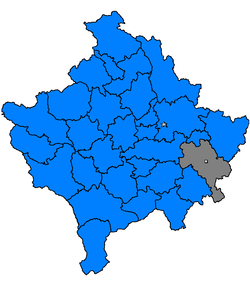Gjilan: Difference between revisions
No edit summary |
|||
| Line 1: | Line 1: | ||
{{Infobox Settlement<!--See Infobox Settlement for more fields -->| |
#REDIRECT [[Gjilan]]{{Infobox Settlement<!--See Infobox Settlement for more fields -->| |
||
official_name = Gjilan / Gjilani<br>Гњилане / ''Gnjilane'' | |
official_name = Gjilan / Gjilani<br>Гњилане / ''Gnjilane'' | |
||
image_flag = | |
image_flag = | |
||
Revision as of 07:44, 18 April 2008
Redirect to:
Gjilan / Gjilani Гњилане / Gnjilane | |
|---|---|
 | |
| District | District of Gnjilane |
| Municipality | Municipalityof Gnjilane |
| Government | |
| Population (2006) | |
| • Total | over 130,000 [1] |
| • Density | 253/km2 (660/sq mi) |
| Time zone | UTC+1 (CET) |
| Area code | +381 280 |
| Website | Municipality of Gnjilane |
Gnjilane or Gjilan (Albanian: Gjilani or Gjilan, Serbian: Гњилане, Gnjilane) is a city and municipality in eastern Kosovo. Located at 42.47° North, 21.48° East, it is the administrative center of the District of Gnjilane.It is famous for having been recorded the lowest temperature in Kosovo with -32.5C on January 25th,1963.
Name and history
The origin of the town name is disputed. Albanian sources claim that the town was originally established in 1772 by the Gjinolli family, who arrived from Novo Brdo, one of the most important late-medieval cities in the central Balkans. However, there is no definite evidence to support that claim, and in fact no one can confirm as to who the first true inhabitants were, or when they first settled there.
In 1915, in and around the city, the Serbian army made a futile stand against the 1st Army of Bulgaria, during the World War I Battle of Kosovo. That battle resulted in the ultimate defeat of the Serbian military, and the occupation by the forces allied with the then German Empire. In World War II there was a significant amount of activity in and around Gnjilane by the Partisans fighting against Nazi Germany and her allies. Monuments to these actions can still be found today, one of which is located in the middle of the village of Koretiste. In 1999, Camp Monteith was established outside the city as a base of operations for KFOR during Operation Joint Guardian, on the site of a destroyed Serbian military base. Gnjilane has also served as the regional headquarters of the UNMIK International Police task force from 1999.
Population
| Ethnic composition | |||||||||||||
| Year/Population | Albanians | % | Serbs | % | Roma | % | Others | % | Total | ||||
|---|---|---|---|---|---|---|---|---|---|---|---|---|---|
| 1953 | 24,797 | 50.87 | 19,196 | 39.32 | 48,748 | ||||||||
| 1961 | 29,942 | 57.12 | 18,297 | 34.91 | 735 | 1.50 | 52,415 | ||||||
| 1971 | 43,754 | 64.45 | 20,237 | 29.81 | 1,824 | 2.69 | 67,893 | ||||||
| 1981 | 59,764 | 71.08 | 19,212 | 22.85 | 3,347 | 3.98 | 1,762 | 2.1 | 84,085 | ||||
| 1991 | 79,357 | 76.54 | 19,370 | 18.68 | 3,477 | 3.4 | 1,471 | 1.4 | 103,675 | ||||
| 1998 | 94,218 | 79.4 | 19,481 | 16.4 | 3,568 | 3 | 1,387 | 1.2 | 118,654 | ||||
| 2003 (August) | 116,000 | 89.4 | 12,300 | 9.5 | 350 | 0.2 | 1,005 | 0.8 | 129,690 | ||||
| Source: Yugoslav Population Censuses for data through 1991, OSCE estimates for data from 1998 and 2003 | |||||||||||||
In 2003, the Gnjilane municipality was estimated to have 133,724 citizens, out of which 79,898 live in the urban area.[citation needed]
Economy
There are 3,700 registered private businesses in the municipality employing 7,900 people. Before 1999, Gnjilane was an important industrial centre in Kosovo. Still in operation are the radiator factory and tobacco factory, which has been recently privatized. The new city business incubator, supported by the European Agency for Reconstruction, was inaugurated in Summer 2007.
Features
Gnjilane is now the administrative center of the District of Gnjilane of Kosovo. Since February 15 2003, it is the headquarters of the Local Democracy Agency in Kosovo of the Council of Europe.
Sports
Gnjilane is home to the basketball club Drita Gjilan and the football clubs KF Gjilani and KF Drita.
References
External links

